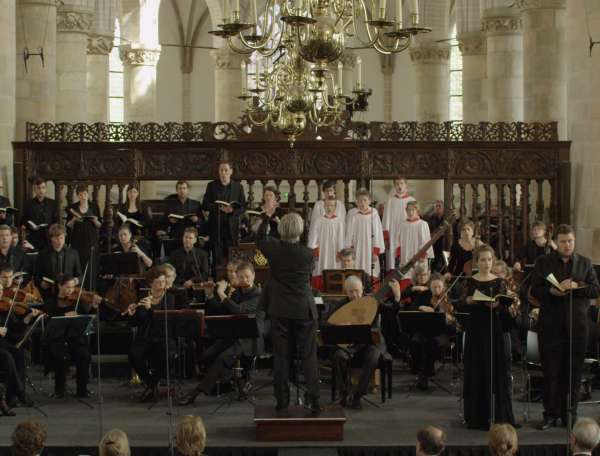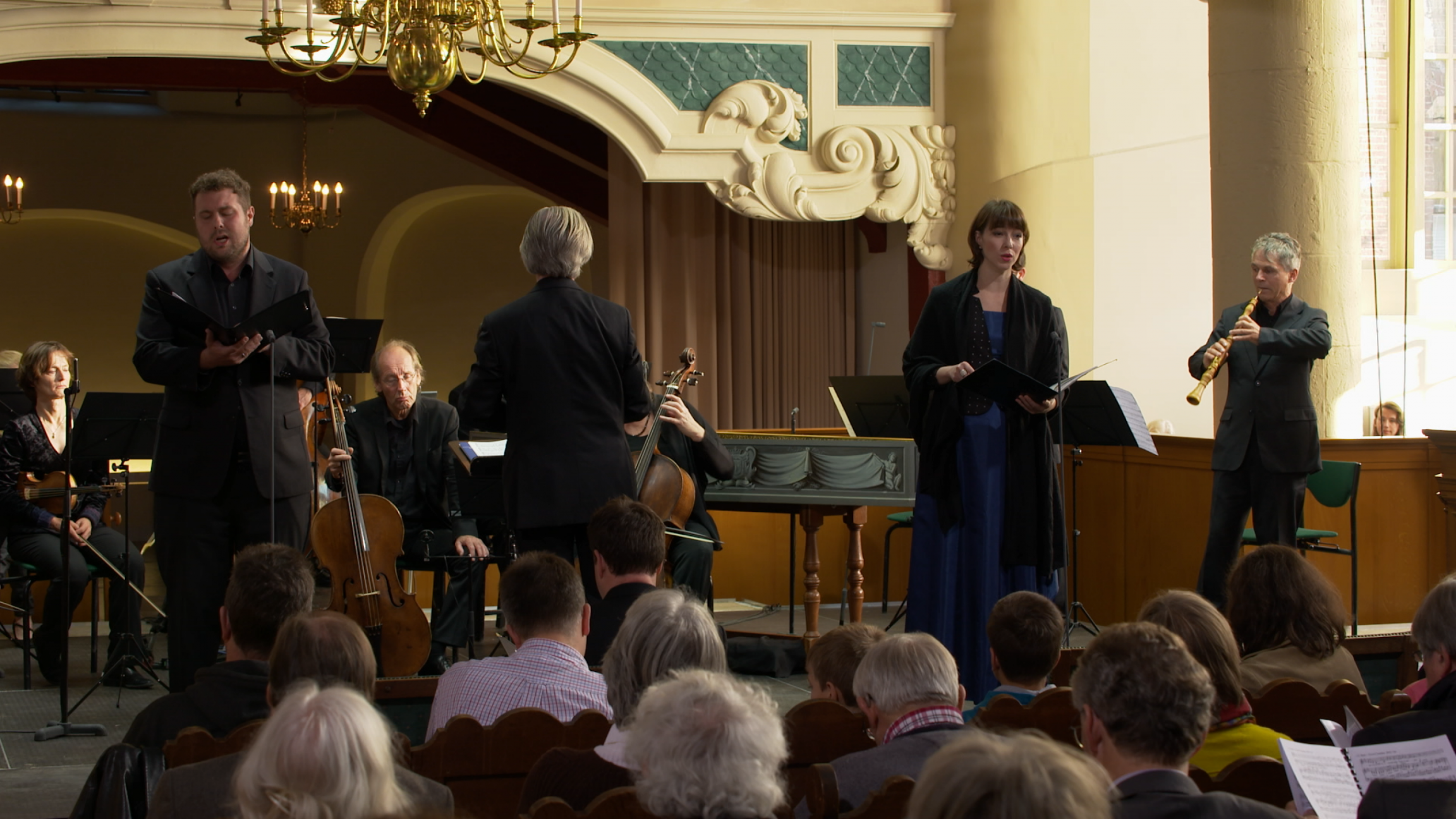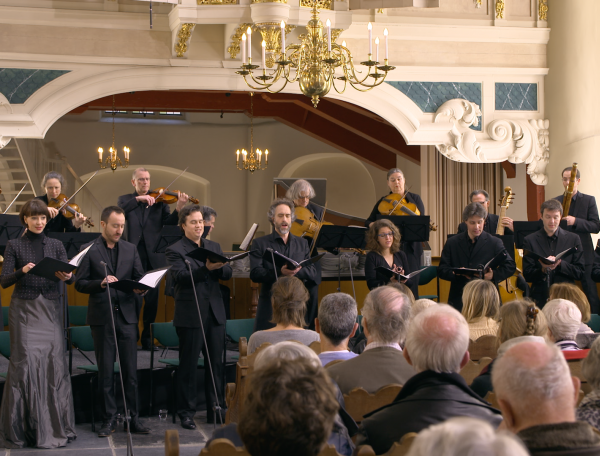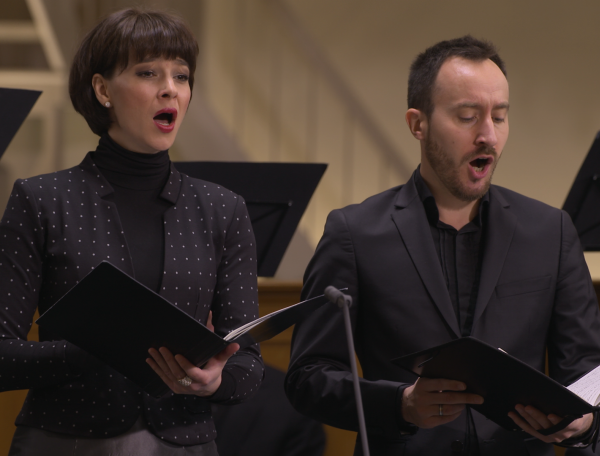

Sehet, wir gehn hinauf gen Jerusalem
BWV 159 performed by the Nederlands Bach Society
conducted by Jos van Veldhoven
Walloon Church, Amsterdam
Behind the music
Mini passion
A cantata for a great organ and just four singers
This piece is evocative of Bach’s St Matthew and St John Passions. In a wonderful dialogue, Jesus tells that he is going to Jerusalem. The soul (an alto) tries to warn him: be careful, your cross is waiting for you there! The main themes of submission and suffering are emotional ones. Alto Alex Potter thinks that such a duet must have come as a shock to the congregation in Leipzig. “The idea of Bach as a devout father of church music arose in the nineteenth century. But in Bach’s day, sung dialogues were associated mainly with opera, and they would have seemed distasteful to the most pious worshippers”.
The cantata was written for the last Sunday before Lent. In the final aria, the bass sings ‘Es ist vollbracht’. Alex Potter: “Of course, this is not a tragic ending, as the crucifixion marks the completion of God’s plan. Listen to the strings, which form a sort of halo effect like the one Christ had in the St Matthew Passion but lost when he was on the cross. Now the halo has returned, as Jesus has triumphed over death and brought salvation”.
four soloists
We are performing this cantata with just four singers. They all have solos, and the piece closes with a final chorale sung altogether. In some performances, extra singers join in with a four-part finale like this, creating a small choir. We do not know what Bach himself did, as he gives no indication of how many singers he wanted to use.
In this performance, we have opted for four soloists. This makes the lines more expressive and you hear more detail. “For a two or three-part section in Bach’s music, nobody would think of using more voices for each part. But if there are four parts, then it suddenly has to become a choir. I think the decision to use just four singers is well justified for a cantata like this, which does not involve many instruments”, says artistic director and conductor Jos van Veldhoven.
location and organ
This recording was made in the Walloon Church in the heart of Amsterdam. Not only does the church have good acoustics, but it is also a place of pilgrimage for organists due to its Müller organ from 1739.
Organist Leo van Doeselaar: “This is one of the finest small Baroque organs in the Netherlands. Gustav Leonhardt was the organist at the Walloon Church from 1959 to 1982. He had the organ restored to its original state as early as the 1960’s. It’s a real pioneer’s organ”. For this performance, we are actually using this ‘great’ organ. A box organ is an anachronism, which was never used in Bach’s day.
“In Bach’s church music, the great church organ always played the continuo parts. In principle, it had the same soft registration as a box organ, but the much wider scaled pipes of the church organ form a more important component of the timbre of a Baroque ensemble. For chorales and choirs of the Baroque period, stronger registers were used and the bass line was played on the pedal, with a 16-foot double-bass register. The fact that it was never done like this before is actually one of the unintentional falsifications of the historical sound approach”, says organist Leo van Doeselaar.
- BWV
- 159
- Title
- Sehet, wir gehn hinauf gen Jerusalem
- Instrument
- bass, oboe
- Genre
- cantatas
- Year
- 1729
- City
- Leipzig
- Lyricist
- Christian Friedrich Henrici (alias Picander)
- Occasion
- Quinquagesima (the last Sunday before Lent)
- First performance
- 27 February 1729?
Extra videos
Vocal texts
Original
1. Arioso (Jesus) und Rezitativ (Seele)
Sehet,
Komm, schaue doch, mein Sinn,
Wo geht dein Jesus hin?
wir gehn hinauf
O harter Gang! Hinauf?
O ungeheurer Berg,
den meine Sünden zeigen!
Wie sauer wirst du müssen steigen!
gen Jerusalem.
Ach, gehe nicht!
Dein Kreuz ist dir schon zugericht',
wo du dich sollt zu Tode bluten.
Hier sucht man Geisseln vor,
dort bindt man Ruten;
Die Bande warten dein.
Ach, gehe selber nicht hinein!
Doch bliebest du zurücke stehen,
so müsst ich selbst
nicht nach Jerusalem,
ach, leider in die Hölle gehen.
2. Arie mit Choral (Sopraan, Alt)
Ich folge dir nach,
Ich will hier bei dir stehen.
Verachte mich doch nicht!
durch Speichel und Schmach,
Von dir will ich nicht gehen.
am Kreuz will ich dich
noch umfangen,
bis dir dein Herze bricht.
dich lass ich nicht aus meiner Brust,
Wenn dein Haupt wird erblassen
im letzten Todesstoss.
und wenn du endlich scheiden musst,
Alsdenn will ich dich fassen,
sollst du dein Grab in mir erlangen.
in meinen Arm und Schoss.
3. Rezitativ (Tenor)
Nun will ich mich,
mein Jesu, über dich
in meinem Winkel grämen.
Die Welt mag immerhin
den Gift der Wollust zu sich nehmen,
ich labe mich an meinen Tränen
und will mich eher nicht
nach einer Freude sehnen,
bis dich mein Angesicht
wird in der Herrlichkeit erblicken,
bis ich durch dich erlöset bin;
da will ich mich mit dir erquicken.
4. Arie (Bass)
Es ist vollbracht,
das Leid ist alle,
wir sind von unserm Sündenfalle
in Gott gerecht gemacht.
nun will ich eilen
und meinem Jesu Dank erteilen;
Welt, gute Nacht!
Es ist vollbracht!
5. Choral
Jesu, deine Passion
ist mir lauter Freude,
deine Wunden, Kron und Hohn
meines Herzens Weide.
Meine Seel auf Rosen geht,
wenn ich dran gedenke;
in dem Himmel eine Stätt
mir deswegen schenke.
Translation
1. Arioso and Recitative
Behold!
Come, behold, my heart,
where does your Jesus go?
We go up
O cruel path! Up?
O monstrous mountain,
that my sins display!
How tough will your ascent be!
to Jerusalem.
Ah, do not go!
The cross is already prepared for Thee,
where Thou must suffer bloody death;
here they look for scourges,
there they bind rods;
the fetters await Thee;
ah, do not Thyself enter in!
But if Thou wert to remain behind,
I myself would not have
to journey to Jerusalem,
ah! but regrettably to hell.
2. Aria with Chorale
I follow Thy path
I shall stand by Thee,
do not despise me!
through spittle and shame;
I shall not leave Thy side,
I shall embrace Thee
once more on the cross,
until Thy heart breaks.
I shall not let Thee leave my breast,
When Thy head turns pale
upon death’s final stroke,
and when Thou finally must part,
even then shall I enfold Thee,
Thou shalt find in me Thy tomb.
in my arms’ embrace.
3. Recitative
Now shall I,
my Jesus, grieve
for you in my retreat;
the world might still consume
the venom of voluptuousness,
but I shall restore myself with weeping
and shall not yearn
for any pleasure,
until my countenance
has glimpsed Thee in Thy majesty,
until I have been redeemed through Thee;
then shall I find refreshment with Thee.
4. Aria
It is finished,
the pain is over,
from the Fall into sin we are now
justly restored to God.
Now shall I hasten
and give my thanks to Jesus,
world, good night!
It is finished!
5. Chorale
Jesus, Thy passion
is unalloyed joy to me,
Thy wounds, Thy crown and scorn
are my heart’s pasture;
my soul walks on roses
when I think of this:
that Thou dost prepare
a place in Heaven for me.
Credits
-
- Release date
- 14 July 2017
-
- Recording date
- 22 October 2016
-
- Location
- Walloon Church, Amsterdam
-
- Conductor
- Jos van Veldhoven
-
- Soprano
- Miriam Feuersinger
-
- Alto
- Alex Potter
-
- Tenor
- Thomas Hobbs
-
- Bass
- Stephan MacLeod
-
- Violin 1
- Shunske Sato, Pieter Affourtit, Anneke van Haaften, Hanneke Wierenga
-
- Violin 2
- Sayuri Yamagata, Paulien Kostense, Annelies van der Vegt
-
- Viola
- Staas Swierstra, Jan Willem Vis
-
- Cello
- Lucia Swarts, Richte van der Meer
-
- Double bass
- Robert Franenberg
-
- Oboe
- Martin Stadler
-
- Bassoon
- Benny Aghassi
-
- Organ
- Leo van Doeselaar
-
- Harpsichord
- Siebe Henstra
-
- Director
- Bas Wielenga
-
- Assistant director
- Ferenc Soetman
-
- Music recording
- Guido Tichelman, Bastiaan Kuijt, Pim van der Lee
-
- Music edit and mix
- Guido Tichelman
-
- Camera
- Bart ten Hakel, Merijn Vrieling, Ivo Palmen, Chris Reichgelt
-
- Camera stagiair
- Klazina Westra
-
- Lights
- Zen Bloot
-
- Lighting assistant
- Patrick Galvin, Henry Rodgers
-
- Video engineer
- Vincent Nugteren
-
- Set technique
- Justin Mutsaers
-
- Data handling
- Jesper Blok
-
- Projectmanager NEP
- Jochem Timmerman
-
- Project preparation nep
- Peter Ribbens
-
- Interview
- Gijs Besseling, Marloes Biermans
-
- Producer concert
- Imke Deters
-
- Producer film
- Jessie Verbrugh
Discover
Help us to complete All of Bach
There are still many recordings to be made before the whole of Bach’s oeuvre is online. And we can’t complete the task without the financial support of our patrons. Please help us to complete the musical heritage of Bach, by supporting us with a donation!

